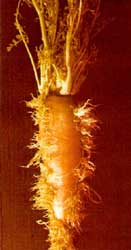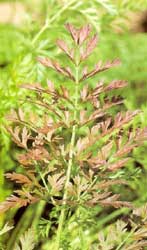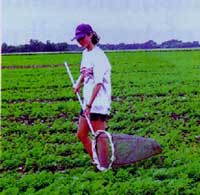Aster Leafhoppers And Aster Yellows
Aster yellows is a viral-like disease and is caused by a phytoplasma (previously called mycoplasma-like organism) and is spread by aster leafhoppers. The insects and the phytoplasma have a very wide host range, including many crops grown in Manitoba, like canola, carrot and potato.
Introduction
The degree of severity of disease can not be assumed from the number of aster leafhoppers (ALH) present due to many different factors. Factors such as weather conditions, percent infective ALH and precipitation amounts are variable and differ from year to year.
Background And Biology
The aster leafhopper is olive-green or straw coloured with six dark coloured spots on the forehead. The abdomen is charcoal and the wings are opaque. They fly between plants in short bursts, depending on wind conditions. They may overwinter as eggs, but substantial numbers migrate from the south, usually arriving in early to mid June. The aster leafhopper will not fly at temperatures below 15ºC. The migrants are attracted to grasses and forages, such as winter wheat and alfalfa, for breeding purposes. The eggs takes two weeks and five nymphal stages to reach the first generation, which appear in late June to early July. These cause most of the crop damage, due to their preference for carrots, lettuce and celery as a feeding ground. The feeding itself is not economically damaging, but in the feeding process the plants are infected with aster yellows.

Figure 1 Aster leafhopper
Disease Life Cycle
Aster leafhoppers are infected by feeding on infected host plants such as pineapple weed and wild carrot. After the leafhopper is infected, it takes two to three weeks for the leafhopper to become capable of transmitting the disease. The leafhoppers then feed on and infect plants including carrots, celery and lettuce. Younger plants will show symptoms several days after infection, while older plants may take several weeks. In Manitoba the % infective ALHs are normally 2-3%; however, in 2012 the infectivity was significantly high, ranging from 10-15%.
Damage
Serious outbreaks of aster yellows can be caused by large number of migrant leafhoppers hoppers. In the spring, warm weather in May and June, and adequate precipitation and soil moisture favour ALH infestation. Aster yellows is not fatal to the infected plants but does distort floral parts and yellows leaves.
In carrots, symptoms known as "red top," include increased root hairs and stunted root growth (Figure 2). Younger foliage will appear yellow, turning to red or purple. The petioles will be dwarfed and twisted, with a dense fern-like growth of shoots (Figure 3). The infected carrot will taste bitter and will appear slender and elongated.

Figure 2 Carrot root affected by aster yellows disease

Figure 3 Fern-like growth of sheets
Monitoring
Growers can reduce the guesswork in pesticide application by monitoring the leafhoppers with sticky traps and sweep nets (Figure 4). Monitoring should take place between the end of May to mid-August. Early detection and increases in leafhopper populations can be detected with yellow sticky traps.
Thresholds are based on monitoring by sweep-netting. Fine nylon sweep nets are passed over dry foliage throughout the carrot field. Counts are based on the number of leafhoppers caught per 100 sweeps.

Figure 4 Sweep netting for detection of aster leafhoppers
Aster Yellows Index Thresholds
The Aster Yellows Index (AYI) indicates potential severity and is calculated by multiplying the sweep netting counts by percent infectivity.
Aster Yellows Index = Percent Infectivity1 x Leafhoppers per 100 sweeps
Aster Yellows Index Thresholds for Several Carrot Varieties
| Resistant AYI = 100 | Intermediate AYI = 75 | Susceptible AYI = 50 2 |
| Charger | Casey | Bonanza |
| Gold King | Goldpak 28 | Candy Pak |
| Hi Color | Goldpak G | Danvera 126 |
| Impak | Long Imperator | Goldpak |
| Royal Chantenay | Nanco | Lucky's Gold |
| Scarlet Nantes | Pakmor | Nantes |
| Scarlet Nantes ST | Spartan Fancy | Nantesa Superior |
| Six-Pak | Triple Gold | Orlando Gold |
| Red-core Chantenay | ||
| Spartan Bonus |
Integrated Pest Management Of Aster Yellows
Cultural Control
Cultural control options available to commercial carrot growers include the planting of resistant varieties and weed control in headlands and ditches to reduce the presence of host plants. Irrigation can increase the attractiveness of carrots by increasing soil moisture which maintains plant succulence.
Weed Hosts Of Aster Yellows
The densities of aster leafhoppers, and hence incidence of the disease, can be strongly influenced by the occurrence of certain host weed species. These weed species include quackgrass, plaintain, chickory, knotweed, pineappleweed, stinkweed, wild asters, lambsquaters, sowthistle, ragweed, Kentucky bluegrass and wild carrot.
Chemical Control
Chemical control is presently the most effective means of controlling aster leafhoppers. Timing of spray applications based on monitoring and threshold calculations should be followed.
In the past, growers applied sprays routinely on a weekly basis beginning when the aster leafhoppers first appeared. This resulted in high costs, excessive use of insecticides, encouraged resistance development and often did not provide adequate control. It has been demonstrated that good control can be achieved with a few (one to four) sprays timed to hit the peak population of leafhoppers.
Commercial Crops Affected By Aster Yellows
The aster yellows pathogen infects over 300 hosts, with plant species occurring in 50 families. These hosts include several crops cultivated in Manitoba and other parts of Canada. Aster yellows is capable of infecting such cultivated crops as carrot, celery, cucurbits, potato, sage, tomato, echinacea, canola, flax, barley, wheat, oats, rapeseed, sunflower and faba beans.
Related Article: The Aster Leafhopper - Why Carrots Matter if you are Growing Canola

